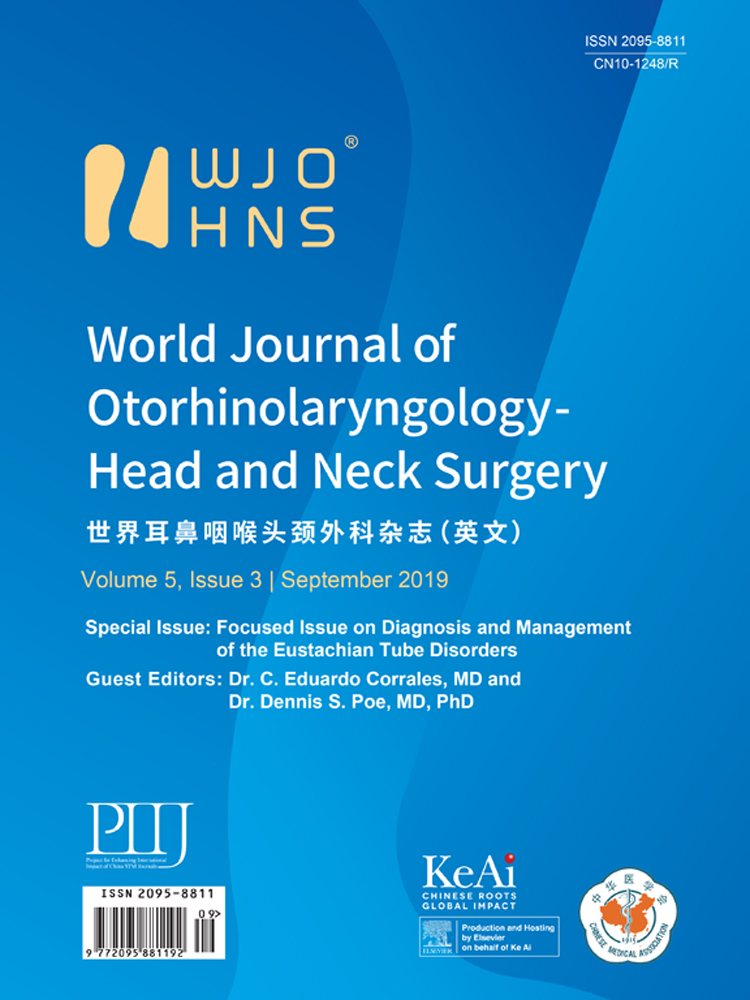The status of Eustachian tube balloon dilations in Nordic countries
Abstract
There is no unanimous consensus for indications of eustachian tube balloon dilation (ETBD). Nordic countries have relatively similar hospital organizations and treatment guidelines. Therefore, it was logical to organize a consensus meeting of ETBD. The symposium: Nordic Experiences on Eustachian Tube Balloon Dilation, in Copenhagen, 30–31 March, 2017. The panellists from Denmark, Finland, Norway and Sweden and the attendees of the meeting agreed a consensus on the following issues: Candidates, Definition of Eustachian Tube Dysfunction, Diagnostic Work up, Differential Diagnosis, Contraindications, ETBD Procedure, Complications, Follow-up, and Outcomes. The article also presents the status for ETBD in each of these countries. Thereafter the consensus statement has been discussed in the national societies and meetings for ear surgeons in each of these countries. It can be assumed that surgeons in the hospitals of these Nordic countries generally follow the recommendations from the consensus meeting.
1 1 Introduction
There is no unanimous consensus for indications of eustachian tube balloon dilation (ETBD). Nordic countries have relatively similar hospital organizations and treatment guidelines. Therefore, it was logical to organize a consensus meeting of ETBD. The initiative for a Nordic consensus symposium for ETBD came from professor Therese Ovesen, Aarhus University, Denmark. A working group of her and Juha Silvola from Norway started to prepare the symposium. The meeting had as goal to define Nordic consensus of diagnosis, indications, treatment and outcomes of ETBD.
2 2 Material and methods
On the day before the symposium, professor Holger Sudhoff (Bielefeld, Germany) hold an outstanding presentation of the past, present and future of ETBD. During the symposium: Nordic Experiences on Eustachian Tube Balloon Dilation, in Copenhagen, 30–31 March, 2017, the panellists (Juha Silvola, Norway; Saku Sinkkonen, Finland; Jens Wanscher, Denmark; Eva Westman, Sweden) and the attendees of the meeting agreed upon the following for the consensus: Candidates, Definition of Eustachian Tube Dysfunction, Diagnostic work up, Differential diagnosis, Contraindications, ETBD procedure, Complications, Follow-up, and Outcomes.
Each panellist gave his or her own presentation of these themes. Thereafter the consensus meeting made in plenum a Nordic recommendation for each issue. This article also presents the status for ETBD in each of these countries.
Objective: Establish a Nordic consensus evaluating the diagnosis, indications, treatment and outcomes of ETBD.
3 3 Results
3.1 3.1 Nordic consensus on Eustachian Tube Balloon Dilation (ETBD)
Candidates: adults (≥18 years), only selected pediatric cases are offered ETBD.
Definition of Eustachian Tube Dysfunction (ETD): There are three types of ETD, obstructive, acutebaro-induced and tuba aperta, according to: Schilder et al. “Eustachian tube dysfunction: consensus statement on definition, types, clinical presentation and diagnosis”.1
Diagnostic work up: thorough endoscopy of the nasal cavity and pharynx, otomicroscopy, Valsalva, Toynbee, tympanometry, and audiometry. CT by indication. Tympanostomy tube treatment is recommended before ETBD. The diagnosis of ETD should be doubted if the patient does not gain any benefit of tympanostomy tube treatment. More studies are warranted on tubomanometry and the 7 item questionnaire ETDQ7.
Differential diagnosis: patent ET (presence of respiratory autophony, movements of the tympanic membrane during reflex decay measurement, and absence of conductive hearing loss) and anatomical variations of the inner ear (third window, like Minor's Syndrome) that mimick patent ET.
Contraindications: patent ET, malformations of the temporal bone and carotid artery.
ETBD procedure: general anaesthesia (local anaesthesia may be used in selected cases). If indicated, the procedure is performed on both ears. Other middle ear surgery may be performed in the same anaesthesia, e.g., tympanostomy, myringotomy, removal of cholesteatoma.
Complications: rare; emphysema due to balloon rupture or tear of the mucosae followed by too early Valsalva manoeuvre, patent ET (probably due to wrong diagnosis before ETBD).
Follow-up: 3, 6, and 12 months (at least) with otomicroscopy, Valsalva, tympanometry, and audiometry. Patient reported outcome.
Outcome: 70%-80% experiences various degrees of improvement according to the literature.
3.2 3.2 ETBD status in Denmark
In 2012, ETBD was introduced as a treatment of ETD in Denmark. Since then, 1119 procedures have been performed (Fig. 1). So far, ETBD is performed at seven centers across Denmark: Rigshospitalet (Copenhagen), Nordsjællands Hospital, Zealand University Hospital, Odense University Hospital/OUH Svendborg Sygehus, Hospital of South West Jutland, Aalborg University Hospital and Regional Hospital West Jutland.
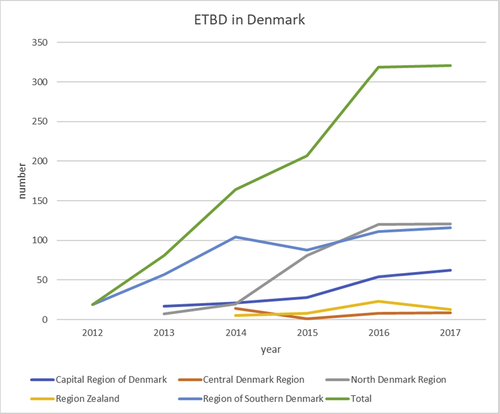
Number of ETBDs per year in Denmark.
In January 2019, a national consensus paper was published in the Danish Medical Journal.2 The author-list consists of one author of each center performing ETBD. We aim to create a national database where all patients, who undergoes first time ETBD in Denmark, are registered. This will facilitate further research and possibly help assessing which factors increase the likeliness of effect from ETBD. This will make it possible to offer ETBD to patients who are expected to benefit from the treatment.
3.3 3.3 ETBD status in Finland
In 2009, ETBD was introduced as a treatment of ETD in Finland. Since then, 1452 procedures have been performed (Fig. 2), about 300 operations yearly per 5.5 million inhabitants. ETBD is performed by otolaryngologists at all the levels of health care: at the five university hospitals, at central hospitals around the county, and also at private institutions.
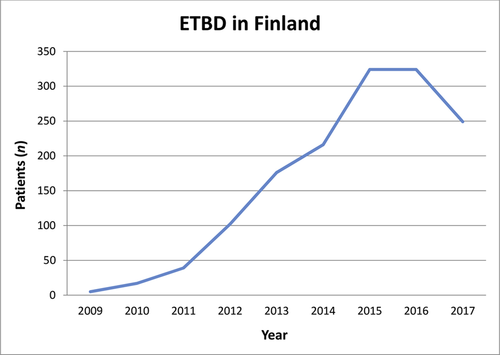
Number of patients treated with ETBD per year in Finland (Source: National Institute for Health and Welfare).
In the 2016 annual meeting of the Finnish Otosurgical Society there was a workshop on ETBD. The workshop included a review of the eustachian tube physiology, middle ear aeration mechanisms, and ETBD outcome studies. Thereafter, the members of the society first voted and then discussed 14 patient cases in order to conclude whether ETBD was indicated in each case. Subsequently, a consensus statement on the possible indications for ETBD was outlined. The proposed indications for ETBD by the Finnish Otosurgical Society in 2016 included (1) chronic bothersome symptoms referring to ETD, (2) baro-induced ETD, and (3) recurring serous otitis media.3 With the available evidence, it was suggested to treat only adults with ETBD. It was stressed that the patient selection was of crucial importance. Diagnosis of the dysfunction should be done according to the consensus statement.1 Chronic sinusitis, nasal polyposis, allergies, reflux disease and enlarged adenoid should always be treated beforehand. It is recommended to stop smoking. Before the operation there should always be prior test and benefit with the tympanostomy tubes, excluding the cases of baro-induced ETD.
3.4 3.4 ETBD status in Norway
ETBD was introduced in Norway in 2012. Two national courses have been arranged since then and the interest for ETBD is increasing.
The total number of ETBD in Norway is difficult to collect, as the sales agents have changed and are not available anymore. The sale of Acclarent Aera balloon ceased in 2015 because of the lack of CE certificate. Thereafter all hospitals have gradually turned to use the Spiggle&Theis 3.2 × 20 mm balloon until 2017 when also the Entellus balloon came to markets. The numbers for Spiggle&Theis balloon sold since 2015 are shown in Fig. 3. The main use is in the South-East Health District, with 2 large university hospitals. About 10% of the procedures are performed in private hospitals and clinics.
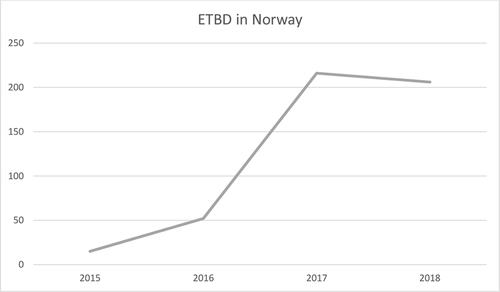
Number of numbers for Spiggle&Theis balloon sold in Norway per year.
All but one of the five university hospitals use ETBD, and the last university hospital has also signaled interest to start with ETBD.
One of the problems with increased use of ETBD is the reimbursement system in Norway, that makes ETBD procedure economically little attractive.
The population of Denmark, Finland and Norway is equal, about 5 million, and it seems that the use of balloons has stabilized now to the level of 300 balloon dilations a year in Denmark and Finland. This is one ETBD procedure per 18 000 inhabitants. The figures in Norway are a little bit lower compared with other Nordic countries with equal population. There is a clear increasing interest to ETBD and it can be assumed that the use will rise to the same level of Denmark and Finland.
In Norway the need for clinical hands-on courses for ETBD is obvious. There are now several plans and ongoing clinical studies for ETBD in different indications, alders and combination with ear surgery.
3.5 3.5 ETBD status in Sweden
In 2014 ETBD was introduced in Sweden, primarily in one county. Gradually other clinics started and in 2017 there were 8 ENT clinics performing ETBD. After an inquiry it is estimated that approximately 250 patients have been operated since 2014, either bi- or unilateral (Fig. 4). A majority of these were adults and only a few children. The clinics in the county where ETBD was introduced were responsible for approximately 25% of the procedures in 2018 and half of the total number of patients. The clinicians have generally been cautious with this new treatment option for ETD and several of the university hospitals are not performing this procedure yet. No national consensus has been drafted so far but the Nordic consensus has generally been followed. A few studies have been undertaken, no one published so far, of which one was a RCT comparing two intervention groups with a control group performing Valsalva maneuver. A version of EDTQ-7 in Swedish is used by several clinics but the questionnaire is not validated yet. The number of patients operated annually have decreased since 2015 but might increase in the future. This will probably depend on whether more of the ENT clinics, including University hospitals and the private clinics, will start with ETBD as a treatment option. A general comment is that more data, including results from long-term follow-up, are needed.
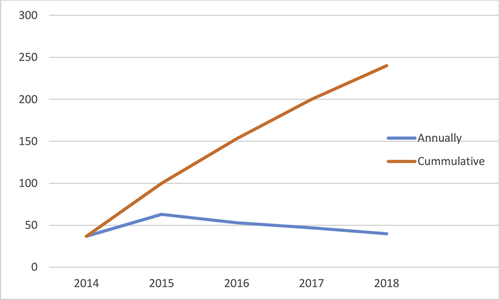
Estimated number of patients operated with ETBD, either bi- or unilateral procedures, per year in Sweden from February 2014 to December 2018.
4 4 Discussion
The use of ETBD seems to have reached a steady state in Denmark and Finland. This is probably not indicative for the true amount of patients who can benefit from this procedure, but delay with new methods and instruments. Nordic countries have relatively similar public hospital service and the otolaryngologists in Nordic countries follow the development in neighboring countries. It can be anticipated that the use of ETBD in Sweden and Norway will gradually increase to the same level as in Denmark and Finland. Further research and evidence of the benefits of ETBD will be needed. It can be assumed that surgeons in the hospitals of Nordic countries generally follow the recommendations of the consensus meeting.
5 Declaration of Competing Interest
We declare that we have no financial and personal relationships with other people or organizations that can inappropriately influence our work, there is no professional or other personal interest of any nature or kind in any product, service and/or company that could be construed as influencing the content of this paper.
6 Acknowledgements
The planning and workout of the symposium was made in co-operation with the Spiggle&Theis company.



